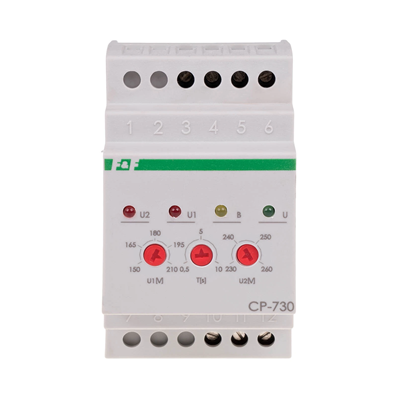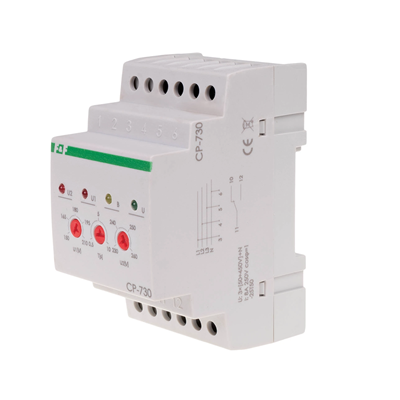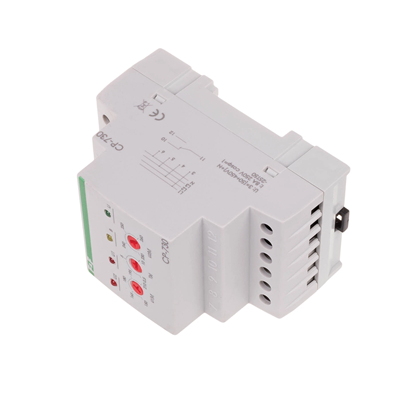CP-730 voltage relay CP-730
Опис товару
Intended use
The CP-730 voltage relay is used to control the voltage of a three-phase network and protect a single-phase receiver against the effects of an increase or decrease in voltage beyond the set values.
Operation
The potentiometers are used to set the lower (U1) and upper (U2) voltage thresholds for all three phases. This is the so-called voltage window, within which phase voltage changes may occur, which do not cause the relay to operate. The correct voltage of the receiver is indicated by the green LED (the contact remains closed, pos. 11-12). Changing the phase voltage on one of the phases above or below the set voltage thresholds will cause the relay to operate (contact opening, pos. 11-10). The voltage drop on one phase below the set U1 value is signaled by the red LED (U1). The voltage increase on one phase above the set U2 value is signaled by the red LED (U2). Re-closing of the contact will take place automatically after the proper voltage is restored. Potentiometer T is used to set the activation time for the lower threshold U1, which means that after exceeding the voltage value below the U1 setting, the contact will be opened with the set delay. Note!
The relay can be supplied with voltage up to 450V~. This allows for effective protection of the receiver even when the voltage exceeds the permissible standards. Also in cases of power supply polarity reversal or "zero" disconnection it will not cause destruction ("burning") of the relay.
As a result of unstable voltage in the network and frequent changes of the supply voltage beyond the set voltage window thresholds (at least 10 times in 1 minute), the relay is blocked for 10 minutes (contact stays in position 11-10). This prevents too frequent, cyclical switching on and off of the connected receiver. The lock state is indicated by the yellow LED.
| Activation time - for threshold U1 [s] | 0, 5-10 |
Технічні дані
-
Number of contacts0NO 0NC
-
InstallationOn the TH-35 rail
-
Actuation threshold - upper [V]230-260
-
Lock indicationyellow LED
-
Power indicationLED green
-
Dimensions3 modules (52.5mm)
-
Package height [mm]150
-
Package weight [kg]0.14
-
Return time for threshold U1 [s]1
-
Return voltage hysteresis - for the U2 threshold [V]5
-
Power [W]1.7
-
load current [A]8
-
connection2.5mm screw terminals
-
Signaling of exceeding voltage thresholds2×LED red
-
Working temperature [°C]From -25-50
-
Power [V]3×(50-450V)+N
-
Package width [mm]60
-
Actuation threshold - lower [V]150-210
-
Return voltage hysteresis - for threshold U1 [V]5
-
PKWIU27.12.23.0
Інші технічні дані
-
Type of electric connectionScrew connection
-
Single-phase under voltage possibleNo
-
Single-phase over voltage possibleNo
-
Single-phase hysteresis possibleYes
-
Contains function DC-under voltageNo
-
Contains function DC-voltage hysteresisNo
-
Type of voltage measuring rangeAC
-
Voltage type for actuatingAC
-
Min. adjustable off-delay time0.1 s
-
Number of contacts as normally open contact1
-
Height90 mm
-
With detachable clampsNo
-
Three-phase under voltage possibleYes
-
Three-phase over voltage possibleYes
-
Three-phase hysteresis possibleYes
-
Contains function DC-over voltageNo
-
Voltage measuring range 2230 ... 260 V
-
Rated control supply voltage AC 50 Hz230 ... 230 V
-
Response value voltage150 ... 260 V
-
Max. permitted off-delay time10 s
-
Width52.5 mm
-
Depth65 mm
Інформація про виробника
-
ВиробникF&F Filipowski S.K.
-
Адреса95-200 Pabianice Konstantynowska 79/81 Polska
-
Електронна пошта
Об'ємна упаковка
| Свого роду пакет | Sztuka |
| Кількість | 1 шт. |
| Вага (кг) | 0,129 |
| Ширина (м) | 0,056 |
| Довжина (м) | 0,095 |
| Глибина (м) | 0,070 |












